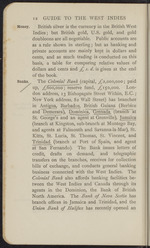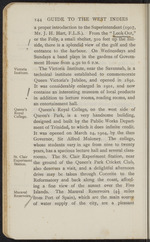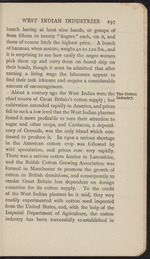| 1 |
 |
“...reserve fund, ^15 0,000. Lon-
don address, 13 Bishopsgate Street Within, E.C.;
New York address, 82 Wall Street) has branches
in Antigua, Barbados, British Guiana (Berbice
and Demerara), Dominica, Grenada (brancfT'at
St. George’s and an agent at Grenville), Jamaica
(branch at Kingston, sub-branch at Montego Bay,
and agents at Falmouth and Savanna-la-Mar), St.
Kitts, St. Lucia, St. Thomas, St. Vincent, and
Trinidad (branch at Port of Spain, and agent
at San Fernando). The Bank issues letters of
credit, drafts on demand, and telegraphic
transfers on the branches, receives for collection
bills of exchange, and conducts general banking
business connected with the West Indies. The
Colonial Bank also affords banking facilities be-
tween the West Indies and Canada through its
agents in the Dominion, the Bank of British
North America. The Bank of Nova Scotia has
branch offices in Jamaica and Trinidad, and the
Union Bank of Halifax has recently opened an...”
|
|
| 2 |
 |
“...Institute, near the Savannah, is a
Institute, technical institute established to commemorate
Queen Victoria’s Jubilee, and opened in 1892.
It was considerably enlarged in 1901, and now
j contains an interesting museum of local products
• in addition to lecture rooms, reading rooms, and
an entertainment hall.
Queen’s Queen’s Royal College, on the west side of
CoUege. Queen’s Park, is a very handsome building,
designed and built by the Public Works Depart-
ment of Trinidad, to which it does infinite credit.
It was opened on March 24, 1904, by the then
Governor, Sir Alfred Moloney. The college,
whose students vary in age from nine to twenty
years, has a spacious lecture hall and several class-
St. Clair rooms. The St Clair Experiment Station, near
!uuio™ent the ground of the Queen’s Park Cricket. Club,
also deserves a visit, and a delightful afternoon
drive may be taken through Cocorite to the
Reformatory and back along the coast, afford-
ing a fine view of the sunset over the Five
Maraval Islands...”
|
|
| 3 |
 |
“...crops, and Carriacou, a depend-
ency of Grenada, was the only island which con-
tinued to produce it. In 1902 a serious shortage
in the American cotton crop was followed by
wild speculation, and prices rose very rapidly.
There was a serious cotton famine in Lancashire,
and the British Cotton Growing Association was
formed in Manchester to promote the growth of
cotton in British dominions, and consequently to
render Great Britain less dependent on foreign
countries for its cotton supply. To the credit
of the West Indian planters be it said, they very
readily experimented with cotton seed imported
from the United States, and, with the help of the
Imperial Department of Agriculture, the cotton
industry has been successfully re-established in...”
|
|
